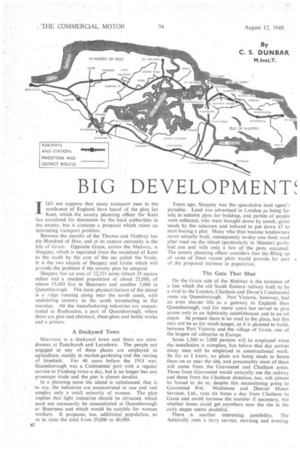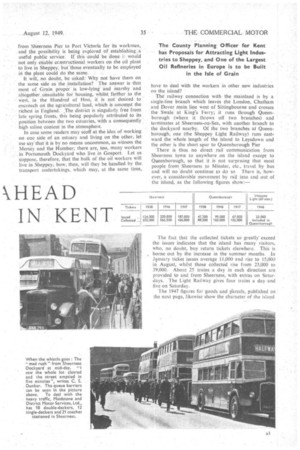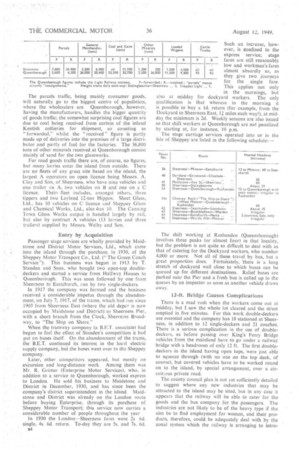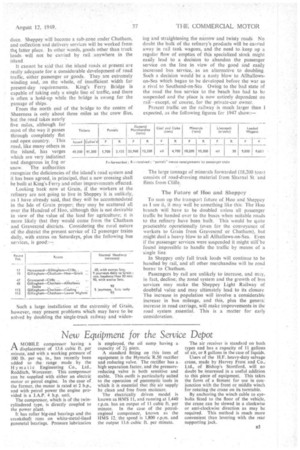BIG DEVELOPNIENT‘,. kHEAD IN KENT
Page 36

Page 37

Page 38

Page 39

If you've noticed an error in this article please click here to report it so we can fix it.
IDO not suppose that many transport men in the south-east of England have heard of the plan for
Kent, which the county planning officer for Kent has circulated for discussion by the local authorities in the county, but it contains a proposal which raises an interesting transport problem.
'Between the mouths of the Thames and Medway lies the Hundred of Hao, and at its eastern extremity is the Isle of Grain. Opposite Grain, across the Medway, is Sheppey, which is separated from the mainland of Kent to the south by the arm of the sea called the Swale. It is the two islands of Sheppey and Grain which will provide the problem if the county plan be adopted.
Sheppey has an area of 22,351 acres (about 35 square miles) and a resident population of about 25,000, of whom 15,000 live in Sheerness and another 3,000 in Queenborough. The main physical feature of the island is a ridge running along near the north coast, with undulating country to the south terminating in flat marshes. All the manufacturing industries are concentrated in Rushenden, a part of Queenborough, where there are glue and chemical, sheet-glass and bottle works and a pottery.
A Dockyard Town • Sheerness is a dockyard town and there are aerodromes at Eastchurch and Leysdown. The people not engaged -at any of these places are employed in agriZulture, mainly in market-gardening and the rearing of livestock. For 40 years before the 1914. war, Queenborough was a Continental port with a regular service to Flushing twice a day, but it no longer has any passenger trade and the pier is almost derelict.
' In a planning sense the island is Unbalanced, that is to say, the industries are concentrated at one end and employ only a small minority of women. The plan implies that light industries should be attracted, which need not necessarily be concentrated at Queenborough Of Sheerness and which would be suitable for women workers. It proposes, too, additional population, so LS to raiSe the total from 25,000 to 40,000. Years ago, Sheppey was the speculative land agent's paradise. Land was advertised in London as being for sale. in suitable plots for building, and parties of people were collected, who were brought down by coach, given meats by the salesmen and induced to put down £5 to start buying a plot Many who thus became landowners never actually built, consequently to-day one finds road after road on the island (particularly in Minster) 'partly laid out and with only a few of the plots occupied The county planning officer considers that the filling up of some of these vacant plots would provide for part of the propcised increase in population.
The Gate That Shut
On the Grain side of the Medway is the terminus of a line which the old South Eastern railway built to be a rival to the London, Chatham and Dover's Continental route via, Queenborough. Port Victoria, however, had an even shoi ter life as a gateway to England than Queenborough, and for many years has served to give access only to an Admiralty establishment and to an oil depot. At present there is no road to the place, but this may not be so for much longer, as it is planned to build, between Port Victoria and the village of Grain, one of the largest oil refineries in Europe.
Some 1,500 to 2,000 pergons will be employed when the installation is complete, but before that day arrives many men will be employed in constructional work. So far as I know, no plans are being made to house them on or near the site, and presumably most of them will come from the Gravesend and Chatham areas. Those from Gravesend would naturally use the railway and those from the Chatham direction, too, will almost be forced to do so, despite this necessitating going to Gravesend first Maidstone and District Motor Services, Ltd., runs six buses a day from Chatham to Grain and could increase the number if necessary, hut whether buses could get anywhere near the site in the early stages seems doubtful.
There is another interesting possibility. The Admiralty .runs a ferry service, morning and evening, from Sheerness Pier to Port Victoria for its workmen, and the possibility is being explored of establishing;.a useful public service. If this could be doe i would not only enable ccnstructional workers on the oil plant to live in Sheppey, but those eventually to be employed in the plant could do the same. . .
It will, no dotibt, be asked: Why not have them on the same side as the _installation? The answer is that most of Grain proper is low-lying and marshy and altogether, unsuitable for housing, whilst farther to the west, in the Hundred of HoO, it is not desired to encroach on the agriciiltural land, which is amongst the richest in England. The district is singularly free from late spring frosts, this being popularly attributed to its position between the two estuaries, with a consequently high saline ccintent in the atmosphere. In case some readers may scoff at the idea of working on one side of an estuary and living on the other, let me say`thatit is by no means uncommon, as witness the Mersey and the Humber; there are, too, many workers in Portsmouth Dockyard who live in Gosport. Let us suppose, therefore, that the bulk of the oil workers will live in Sheppey; how, then, will they be handled by the transport undertakings, which may, at the same time, have to deal with the workers in other new industries on the island?
The railway connection with the mainland is by a single-line branch which leaves the London, Chatham arid .Dover main. line west of Sittingbourne and crosses the Swale at King's Ferry; it runs through Queenborough (where it throws off two branches) and terminates at Sheerness-on-Sea, with another branch to the dockyard nearby. Of the two branches at Queenborough, one (the •Sheppey Light Railway) runs eastward the whole length of the island to Leysdown and the other is the short spur to Queenborough Pier There is thus no direct rail communication from Sheerness town to anywhere on the island except to Queenborough, so that it is not surprising that most people from Sheerness to Minster, etc., travel by bus and will no doubt continue to do so. There is, •however, a considerable movement by rail into and out of the island, as the following figures show:—
The fact that the collected tickets so greatly" exceed the issuesindicates that the island has many .visitors, who, no doubt, buy return tickets elsewhere. This is , borne out by the increase in the summer months. In January ticket issues average 11,000 and rise to 15,000 in August, whilst those collected rise from 23,000 to 39,000. About 25 trains a day in each direction are provided to and from Sheerness, with extras on Saturdays. The Light Railway gives four trains a day and five on Saturday.
The 1947 figures for goods and p–areels, published on the next page, likewise show the character of the island
The parcels traffic, being mainly consumer goods, will naturally go to the biggest centre of population, where the wholesalers are. Queenborough, however, having the manufacturers, handles the bigger quantity of goods traffic; the somewhat surprising coal figures are due to coal being received from certain of the inland Kentish collieries for shipment, so counting as "forwarded," whilst the "received" figure is partly made up of deliveries into the premises of a large distributor and partly of fuel for the factories. The 36,800 tons of other minerals received at Queenborough consist mainly of sand for the two glassworks.
For road goods traffic there are, of course, no figures, but many lorries enter the island from outside. There are no fleets of any great size based on the island, the largest A operators on open licence being Messrs. A. Clay and Son, of Sheerness, who have nine vehicles and one trailer on A, two vehicles on B and one on a C licence. Their fleet includes, amongst others, three tippers and two Leyland 12-ton Hippos. Sheet Glass. Ltd., has 10 vehicles on C licence and Sheppey Glues and Chemical Works, Ltd., also 41as 10. The Canning Town Glass Works output is handled largely by rail, but also by contract A vehicles (13 lorries and three trailers) supplied by Messrs. Welby and Son.
Entry by Acquisition Passenger stage services are wholly provided by Maidstone and District Motor Services, Ltd., which came into the island through the purchase, in 1930, of the Sheppey Motor Transport Co., Ltd. C' The Gieen Coach Service"). This business was begun in 1913 by T. Standen and Sons, who bought two open-top doubledeckers and started a service from Halfway Houses to Queenborough. This was soon followed by one from Sheerness to Eastchurch, run by two single-deckers.
In 1917 the company was formed and the business received a considerable impetus through the abandonment, on July 7, 1917, of the trams, which had run since 1903 from Sheerness East (where the old depot is now occupied by Maidstone and District) to Sheerness Pier, with a short branch from the Clock, Sheerness Broadway, to "The Ship on Shore."
When the tramway company (a BET. associate) had begun to feel the effect of Standen's competition it had put on buses itself. On the abandonment of the trams, the B.E.T. continued its interest in the local electric supply company, but the buses went over to the Sheppey company.
.Later, other competitors appeared, but mostly on excursion and long-distance work. Among them was Mr. R. Griiner (Enterprise Motor Services), who, in addition to a service to Queenborough, worked express to London. He sold his business to Maidstone and District in December, 1930, and has since been the company's district superintendent in the island. Maidstone and District was already on the London route before buying Enterprise, through its purchase of Sheppey Motor Transport; this service now carries a considerable number of people throughout the year
In 1930 the London—Sheerness fares were 2s 6d. single, 4s: 6d. return. To-day they are 5s. and 7s. 6d.
B4 Such an increase, however, is confined to the express service; stage fares are still reasonably low and workmen's fares almoSt absurdly so, as they give two journeys for the single fare. This applies not only in the mornings, but also at midday for dockyard workers. The only qualification is that whereas in the morning it is possible to buy a Id. return (for example, from the Dockyard to Sheerness East, 1,1 miles each way!), at midday the minimum is 2d. Weekly seasons are also issued so that shift workers at Queenborough are not penalized by starting at, for instance, 10 p.m.
The stage carriage services operated into or in the Isle of Sheppey are listed in the following schedule:—
The shift working at Rushenden (Queensborough) involves three peaks (or almost four) in that locality, but the problem is not quite so difficult to deal with as that of catering for the Dockyard workers, who number 4,000 or more. Not all of these travel by bus, but a great proportion does. Fortunately, There is a long stretch of dockyard wall close to which buses can be queued up for different destinations. Relief buses are parked near the Pier and a fresh bus is called up to the queues by an inspector as soon as another vehicle draws away.
12-ft. Bridge Causes Complications
There is a mad rush when the workers come out at midday, but I saw the whole lot cleared and the street emptied in five minutes. For this work double-deckers are essential and the Company has 18 stationed at Sheerness, in addition to 12 single-deckers and 21 coaches. There• is a serious complication in the use of doubledeckers, as before passing over King's Ferry Bridge vehicles from the mainland have to go under a railway bridge with a headroom of only 12 ft. The first doubledeckers in the island having open tops, were just able to squeeze through (with no one on the top deck, of course), but covered vehicles have to be worked round on to the island, by special arrangement, over a circuit:ous private road.
The county council plan is not yet sufficiently detailed to suggest where any new industries that may be attracted to the island may be sited, but in any case it appears that the railway will be able to cater for the goods and the bus company for the passengers. The industries are not likely to be of the heavy type if the aim be to find employment for women, and their products, therefore, could be adequately deal with by the zonal system which the railway is arranging to intro duce. Sheppey will become a sub-zone under Chatham, and collection and delivery services will be worked from thq latter place. In other words, goods other than truck loads will not be carried by rail .anywhere in the island It cannot be said that the island roads at present are really adequate for a considerable developmenr of road traffic, either passenger or goods, They are extremely winding and, on the whole, of insufficient width for present-day requirements. King's Ferry Bridge is capable of taking only a single line of traffic, and there is often a hold-up while the bridge is swung for the passage of ships. From the north end of the bridge to the centre of Sheerness is only about three miles as the crow flies, but the road takes nearly five miles, although fat most of the way it passes through completely fiat and open country. This road, like many others in the island, has verges which are very indistinct and dangerous in fog or snow. The aufhorities recognize the deficiencies of the island's road system and it has been agreed, in principal, that a new crossing shall be built at King's-Ferry and other improvements effected.
Looking back now at Grain, if the Workers at the refinery are not going to live in Sheppey it is unlikely, as I have already said, that they will be accommodated in the Isle of Grain proper; they may be scattered all over the Hundred of 1-loo, although this is not desirable in view of the value of the land for agriculture; it is more likely that they would come from the Chatham and Gravesend districts. Considering the rural nature of the district the present service of 12 passenger trains daily, with extras on Saturdays, plus the following bus services, is good:-
Tickets Issued 49,300 Coilec'd
ParUls R F 91,300 1,700 2,432
Such a large installation at the extremity of Grain, hosvever, may present problems which may have to be solved by doubling the single-track railway and widen
Mg and straightening the narrow and twisty roads. No doubt the bulk of the refinery's products will be carried away in rail tank wagons, and the need to.keep up a regular flow of empties of this specialized stock might easily lead to a decision to abandon the passenger service on the line in view of the good and easily increased bus service, as an alternative to doubling. Such a decision would be a nasty blow to Allhallowson-Sea which began to be developed before the war as a rival to Southend-on-Sea Owing to the bad state of the road the bus service to the beach has had to be suspended and the place is now entirely dependent on rail--except, course, for the private-car owner. Present tra Mc on the railway is much larger than I expected, as the following figures for 1947 show:—
• The large tonnage of minerals forwarded (15,200 tons) consists of road-dressing material from Sharnal St and flints from Cliffe.
The Future of Hoo and Sheppey
To sum up the transport future of Hoo and Sheppey as I see it, it may well be something like this: The Hoo branch will have to be doubled tmless all passenger traffic be handed over to the buses when suitable roads to the refinery have been built. This would be quite practicable operationally (even for the conveyance of workers to Grain from Gravesend or Chatham), but might deal a heavy blow to all Allhallows-orr-Sea. Even if the passenger services were suspended it might still'be found impossible to handle the traffic by means of a single line.
in Sheppey only full truck loads will continue to be handled by rail, and all other merchandise will be road borne to Chatham. .
Passengers by rail are unlikely to increase, and may, in fact, decline; the zonal system and the growth of bus services may make the Sheppey Light Railway of doubtful value and may ultimately lead to its closure The increase in population will involve a considerable increase in bus mileage, and this, plus the genera; increase in road carriage, will make improvements in the road system ,essential. This is a matter for early consideration.




















































































